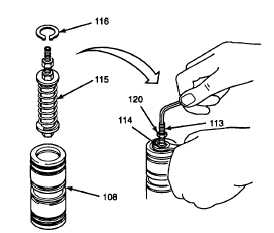TM 5-3895-373-34
E.
ASSEMBLE - Continued.
3.
INSTALL SERVO SPRING INTO SERVO PISTON.
Hydraulic oil can be moderately flammable
and can be an irritant to the skin, eyes, and
respiratory
system.
Avoid
prolonged
exposure. Eye protection and rubber
gloves must be worn when working with
hydraulic oil.
a.
Lubricate all parts with clean hydraulic oil.
b.
Slide servo spring (115) into servo piston (108).
c.
Use an allen wrench and hold special screw
(113) on
servo spring from turning.
d.
Compress servo piston by tightening hex nut
closest to servo spring with a wrench. Be sure
to expose the complete internal retaining ring
groove. Use two flat-blade screwdrivers to
further compress servo spring to
allow
retaining ring (116)to be installed.
Use care when installing snap and retaining
rings.
Snap and retaining rings are
under spring tension and can act as
projectiles when released and could cause
severe eye injury.
e.
When spring is compressed, install retaining ring
(116).
f.
If retaining ring cannot be installed,
additionally compress servo spring by tightening
inner hex nut.
Be sure retaining ring is fully seated in
groove. Propulsion pump control will be
lost if retaining ring is not fully seated in
retaining ring groove.
g.
Ensure retaining ring is fully seated in retaining
ring groove.
Neutral position cannot be obtained in
propulsion pump if any looseness exists
between servo spring and servo piston.
Ensure servo spring is correctly tightened
and seated inside servo piston. Equipment
damage
may
result
from
improper
installation of servo spring inside servo
piston.
h.
If hex nut (114) is overtightened, servo spring will
be loose in servo piston. Loosen hex nut.
i.
If hex nut (114) is undertightened, special screw
will be loose between spring guides. Tighten
hex nut.
j.
When servo spring is correctly seated inside
servo piston, hold inner hex nut (114) from
turning and tighten outer hex nut (120) against
inner hex nut (114) to 22 lb-ft (30 N•m) to lock
servo spring in position.
GO TO NEXT PAGE
2-415






